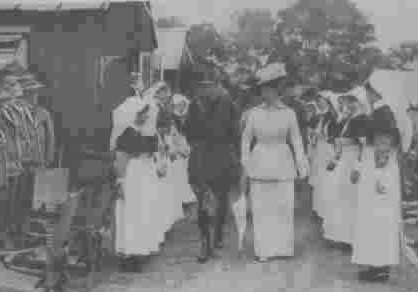|
Australian Women at war, WW1, WW2 - Nursing the A I F in the Great War
The Australian Army Nursing Service, which was actually a reserve, was established on 1 July 1903. The Service was staffed by volunteer civilian nurses who would be available for duty during times of national emergency. Members of the Service served in both the World Wars, staffing medical facilities in Australia and overseas. In 1949 the Service became part of the Australian Regular Army and is now known as the Royal Australian Army Nursing Corps (RAANC). Prior to Australia's Federation in 1901, each colony controlled its own defence force, of which the nursing services formed a part. In July 1903 the nursing services of each colony joined together to form the Australian Army Nursing Service. The Service which was part of the Australian Army Medical Corps was made up of volunteer trained nurses who were willing to serve in times of a national emergency At the outbreak of World War I staff were recruited from both the nursing service and the civilian workforce. They served at field and base hospitals in Australia as well as in Egypt, Lemnos, England, France, Belgium, Greece, Salonika, Palestine, Mesopotamia and India. Acccording to the Australian Department of Defence, 2,562 AANS nurses joined active service during World War I, with 423 of these women serving in Australia..Another 130 with the Queen Alexandra Imperial Nursing Service.
Mother ANZAC, but who was she?
She worked with the Maoris in NZ after she contracted diabetes, was buried with full Maori tribal honours and along the way she revolutionised the AIF attitude to massage (now called physiotherapy). They called her Mother ANZAC but who was she ? She was Staff Nurse Esther Barnett. She he enlisted on August 18, 1915 when the terrible cost of Gallipoli was starting to be realised. Born 1857, she was 57 when she enlisted but she 'forgot' a few years. 3 days after enlisting the qualified masseuse who had worked in London hospitals, was on her way. She and the other 17 male and female practitioners of the art of medical massage were on their way to Egypt. They worked on up to 40 cases per day in a field that was only just starting to be recognised by military authorities. Many patients, particularly shell shocked ones in total or near total paralysis responded well and quickly. Shell shock was likened by many to fear or cowardice but is now recognised as PTSD. She came home in 1917 and worked with the Matron at the 6th Australian General Hospital but duty called and she returned overseas in June of 1918. Illness stopped her getting there and she disembarked in Wellington NZ. After release from hospital she worked amongst the Maori tribes until her death in 1921. Nurses who died in WW1. Military Medal awards to AANS Nurses in WW1. The first bravery awards for Australian women were given to four nurses. On the 22nd July 1917 four members of the AANS, Sisters Caywood, Deacon, Ross-King and Staff Nurse Derrer were awarded Military Medals (MM) for rescuing patients in burning Casualty Clearing Stations. Other Australian nurses to be awarded Military Medal during World War I were Sisters, Pearl Corkhill and Mary Kelly.
At Gallipoli.
She died five months later, in May 1918. Sister Gertrude Doherty, from WA, wrote to her cousin Muriel in Sydney:
A group of Australian nurses sailed for France in 1916, organised by the Australian Red Cross and financed by the Australian Jockey Club. Their blue uniforms were made by department store David Jones, hence their name The Bluebirds. They were, they said, "gifts to France".
The AANS returned to a reserve status. The pledge made by AANS nurses.
|


